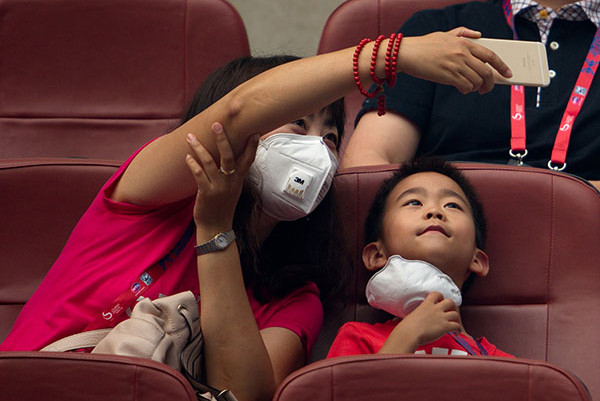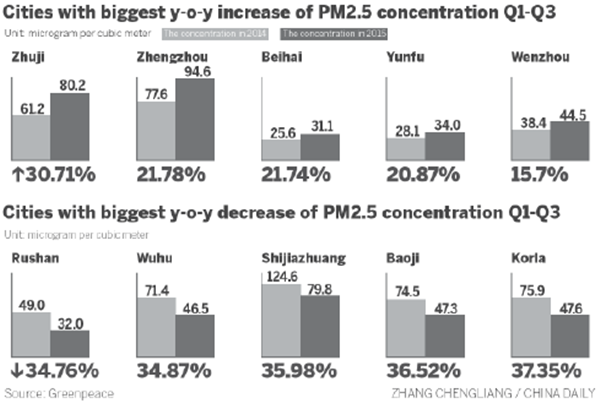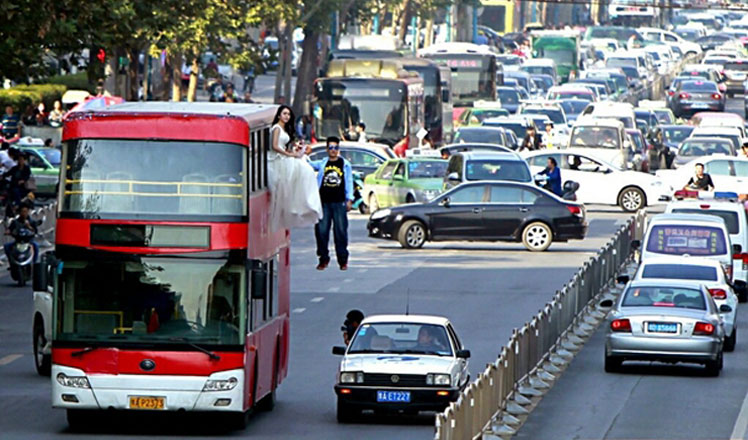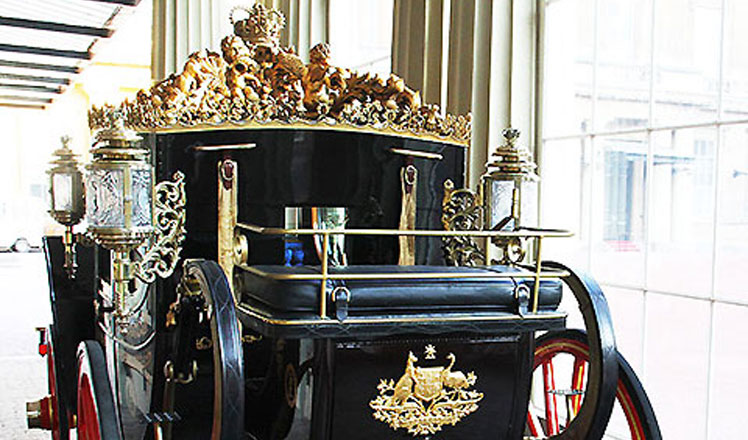Air cleaning effort pays off
Updated: 2015-10-16 07:28
By Zheng Jinran(China Daily)
|
||||||||
 |
|
A mother and son pose for a selfie on Wednesday during a break in the China Open tennis tournament in Beijing, where smog has persisted for days.[Wei Xiaohao/China Daily] |
About 80 percent of China's 367 cities with real-time air quality monitoring capabilities failed to reach national standards on small-particle pollution in the first three quarters of the year, a report by the global environmental organization Greenpeace said on Thursday. Even so, most of the cities have reduced the concentration of fine matter.
The Beijing-Tianjin-Hebei region, which has seen frequent smog since 2013, ramped up efforts this year to rein in emissions and brought a clear reduction in PM2.5 pollution in the first nine months.
The Greenpeace report said it relied on data from the China National Environment Monitoring Center, which updates air quality data hourly on major air pollutants like concentrations of PM2.5, PM10 and sulfur dioxide in the 367 cities.
It showed that in most of the 367 cities the concentration of PM2.5-particulate matter with diameter less than 2.5 microns that can penetrate into lungs and harm human health-failed to meet the national standard on air quality, 35 micrograms per cubic meter.
In the first three quarters, 84 cities met the national standards, including Sanya, Hainan province; Lhasa, in the Tibet autonomous region; and Xiamen, in coastal Fujian province. Nyingchi, a county in Tibet had the best air quality during the period, with PM2.5 concentration of only 10.9 micrograms per cubic meter, according to the report.
Among the places monitored, Kashgar and Khotan in the Xinjiang Uygur autonomous region ranked as the top two most polluted, based on the daily PM2.5 concentration during the period-above 109 micrograms per cubic meter.
The region consumes large quantities of coal and other carbon fuels for heating and is affected by heavy sand and dust as well, which have brought down the air quality, according to a statement by the region's environmental authorities.
Hebei province and Beijing also ranked high on the list, though the PM2.5 concentration was reduced greatly in the first three quarters compared with the same period in 2014, the Greenpeace report said.
Beijing has lowered its PM2.5 concentration by 15 percent year-on-year, Tianjin has reduced it by 17.4 percent and Shijiazhuang, the capital of Hebei province, lowered it by 36 percent, the report said.
"Data on the daily concentration during the period is close to the official data released by the Environmental Protection Bureau," Deng Xiaowen, director of Tianjin's environmental monitoring center, said on Thursday.
The reduction of air pollutants in the cities is the result of comprehensive control efforts, according to Deng, along with other researchers and government officials.
Xie Shaodong, professor of environmental studies at Peking University, added that the government's measures have worked, including restrictions on the growth of polluting industries, shutting down of heavy polluters and imposing limits on vehicle usage during smoggy days.
To reach its goals in air quality, there should be systematic efforts and policies to reform energy consumption, with a cap on coal consumption, which is the key to controlling air pollution, according to Dong Liansai of Greenpeace.
 |
- EU offers Turkey cash, closer ties for migration help
- ROK, Japan to hold defense ministers' talks next week
- 5 countries elected as non-permanent members of UN Security Council
- Obama slows pace of US troop withdrawal in Afghanistan
- Democratic rivals back Clinton on emails
- Myanmar gov't signs ceasefire accord with armed groups

 Shaolin monks display kung fu skills in London
Shaolin monks display kung fu skills in London
 'Newlyweds' are 'floating' on air in Zhengzhou
'Newlyweds' are 'floating' on air in Zhengzhou
 Buckingham Palace prepares for Xi's visit
Buckingham Palace prepares for Xi's visit
 Shanghai Fashion Week: We COUTURE
Shanghai Fashion Week: We COUTURE
 World's top 10 innovative economies
World's top 10 innovative economies
 Cui: China, US should share global vision
Cui: China, US should share global vision
 Speaking Mandarin attracts Chinese homebuyers in the US
Speaking Mandarin attracts Chinese homebuyers in the US
 Top 10 overseas destinations of National Day holidaymakers
Top 10 overseas destinations of National Day holidaymakers
Most Viewed
Editor's Picks

|

|

|

|

|

|
Today's Top News
Tu first Chinese to win Nobel Prize in Medicine
Huntsman says Sino-US relationship needs common goals
Xi pledges $2 billion to help developing countries
Young people from US look forward to Xi's state visit: Survey
US to accept more refugees than planned
Li calls on State-owned firms to tap more global markets
Apple's iOS App Store suffers first major attack
Japan enacts new security laws to overturn postwar pacifism
US Weekly

|

|







